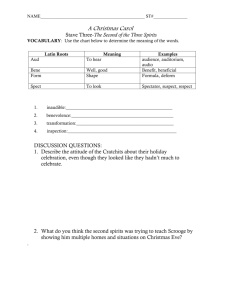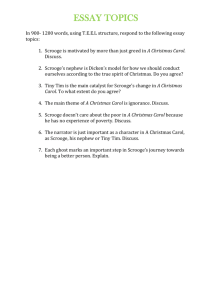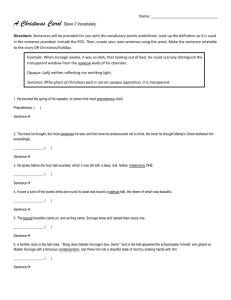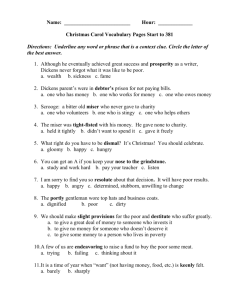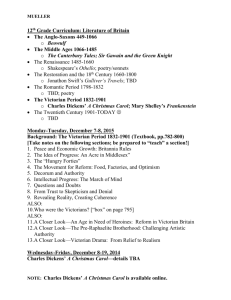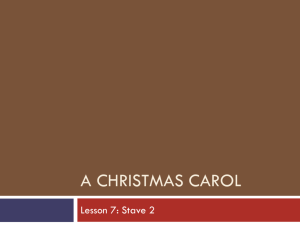A Christmas Carol Unit Plan_6
advertisement
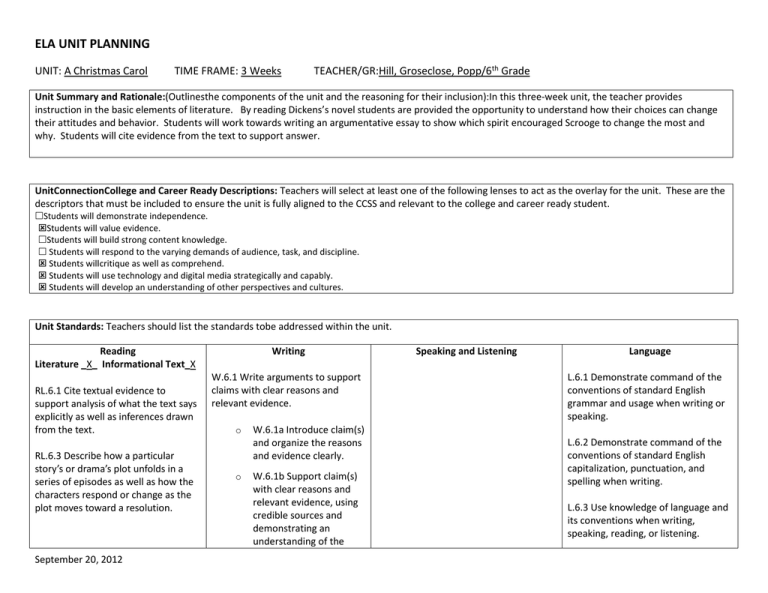
ELA UNIT PLANNING UNIT: A Christmas Carol TIME FRAME: 3 Weeks TEACHER/GR:Hill, Groseclose, Popp/6th Grade Unit Summary and Rationale:(Outlinesthe components of the unit and the reasoning for their inclusion):In this three-week unit, the teacher provides instruction in the basic elements of literature. By reading Dickens’s novel students are provided the opportunity to understand how their choices can change their attitudes and behavior. Students will work towards writing an argumentative essay to show which spirit encouraged Scrooge to change the most and why. Students will cite evidence from the text to support answer. UnitConnectionCollege and Career Ready Descriptions: Teachers will select at least one of the following lenses to act as the overlay for the unit. These are the descriptors that must be included to ensure the unit is fully aligned to the CCSS and relevant to the college and career ready student. Students will demonstrate independence. Students will value evidence. Students will build strong content knowledge. Students will respond to the varying demands of audience, task, and discipline. Students willcritique as well as comprehend. Students will use technology and digital media strategically and capably. Students will develop an understanding of other perspectives and cultures. Unit Standards: Teachers should list the standards tobe addressed within the unit. Reading Literature _X_ Informational Text_X RL.6.1 Cite textual evidence to support analysis of what the text says explicitly as well as inferences drawn from the text. RL.6.3 Describe how a particular story’s or drama’s plot unfolds in a series of episodes as well as how the characters respond or change as the plot moves toward a resolution. September 20, 2012 Writing W.6.1 Write arguments to support claims with clear reasons and relevant evidence. o o W.6.1a Introduce claim(s) and organize the reasons and evidence clearly. W.6.1b Support claim(s) with clear reasons and relevant evidence, using credible sources and demonstrating an understanding of the Speaking and Listening Language L.6.1 Demonstrate command of the conventions of standard English grammar and usage when writing or speaking. L.6.2 Demonstrate command of the conventions of standard English capitalization, punctuation, and spelling when writing. L.6.3 Use knowledge of language and its conventions when writing, speaking, reading, or listening. RL.6.5 Analyze how a particular sentence, chapter, scene, or stanza fits into the overall structure of a text and contributes to the development of the theme, setting, or plot. RL.6.7 Compare and contrast the experience of reading a story, drama, or poem to listening to or viewing an audio, video, or live version of the text, including contrasting what they “see” and “hear” when reading the text to what they perceive when they listen or watch. RL.6.10 By the end of the year, read and comprehend literature, including stories, dramas, and poems, in the grades 6–8 text complexity band proficiently, with scaffolding as needed at the high end of the range. topic or text. o W.6.1d Establish and maintain a formal style. o W.6.1e Provide a concluding statement or section that follows from the argument presented. W.6.2 Write informative/explanatory texts to examine a topic and convey ideas, concepts, and information through the selection, organization, and analysis of relevant content. L.6.4 Determine or clarify the meaning of unknown and multiplemeaning words and phrases based on grade 6 reading and content, choosing flexibly from a range of strategies. L.6.5 Demonstrate understanding of figurative language, word relationships, and nuances in word meanings. RI.6.7 Integrate information presented in different media or formats (e.g., visually, quantitatively) as well as in words to develop a coherent understanding of a topic or issue. Big Ideas: These are what students will discover as a result of instruction and learning activities. They are the main ideas of the learning, the conclusions, or the generalizations. Big Ideas should be open-ended and apply to more than one area of study. Essential Questions: Essential questions center on major issues, problems, concerns, interests, or themes relevant to the classroom. Essential questions should lead students to discover the big ideas. They need to go beyond who, what and where. They need to lead to the how and why. Victorian Era/Life of Charles Dickens Decisions What about Charles Dickens’s childhood may have contributed to him writing the novel, A Christmas Carol? How do the decisions we make today affect our lives in the future? Emotions Impressions What do you think led to Scrooge’s present attitude about Christmas? How did Scrooge’s actions, choices, and values have an impact on the way he was September 20, 2012 viewed by others? Choices Change What about the visit from the Ghost of Christmas Yet to Come makes it different and more frightening than the others? What signals does Charles Dickens give the reader that Scrooge will change? Which spirit caused Scrooge to change the most? Knowledge: What should students know by the end of the lesson? Students will know… The students will be able to demonstrate an understanding of Charles Dickens’s life by summarizing an article read about the author. The student will be able to describe Scrooge’s character and support descriptions with evidence from the text. The students will demonstrate an understanding of Stave 2 of A Christmas Carol by creating a flow map of Scrooge’s journey through his past using the novel as reference. The students will be able to demonstrate understanding of how other characters feel towards Scrooge by citing evidence of good or bad comments that characters say about him. The students will demonstrate an understanding of the final spirits visit to Scrooge by citing textual evidence. Students will be able to compare and contrast the changed Scrooge to the new Scrooge with graphic organizers using the novel as reference. Students will be able to write a five paragraph argumentative paper on which spirit they think caused Scrooge to change the most citing quotations from the text as proof. September 20, 2012 Learning Tasks: Teachers list the various tasks students will engage in throughout the unit, include use of media/other forms of information. Students will be skilled at describing how a story’s plot unfolds in a series of episodes and how the main character responds or changes as the plot moves toward a resolution. Reading Tasks Writing Tasks Discussion Tasks Language/Vocabulary Tasks 3-2-1 on Charles Dickens’s life Scrooge Cluster Map Flow Map on Scrooge’s Journey Through His Past Character Study Chart Predictions T-Chart What Scrooge Was Shown(Chart) Venn Diagram Comparing and Contrasting the novel, play, and movie Exit Slips Quickwrite on Past Argumentative Essay Journal Entries A Christmas Carol Anticipation Guide Christmas Card Activity Think-Pair-Share about Scrooge’s attitude towards Christmas Tiered Vocabulary Presentation Use context a clues to the meaning of or phrases Interpret figures of speech in context Distinguish among the connotations of words with similar denotations Assessment Evidences: List types of assessments that will be used throughout the course of the unit. *If you do not have assessments for this unit, they should be created before moving on to the lesson design* DIAGNOSTIC FORMATIVE SUMMATIVE Stave 1 Quiz Stave 2 Quiz Stave 3 Quiz Stave 4 Quiz Stave 5 Quiz Text(s) Selections/Resources(generated by both teacher and student) Teachers will list the genres/titles/resources for study and indicate text complexity: Article on Charles Dickens A Christmas Carol by Charles Dickens “Water” by Helen Keller September 20, 2012 Common Assessment using the story “Water” by Helen Keller (Multiple Choice Assessment) Notes (include accommodations/grouping/modifications):A Christmas Carol will be used with general Ed and AIG; A Christmas Carol Adapted Version for EC and ELL. We have an Extend II version of the Stave quizzes. Stave 2 – Students will create a flow map of Scrooge’s Journey through his past. (EC and ELL students will be given events to sequence.) Stave 4 - Students will create a T-chart, students will make a list of things that may happen if Scrooge does not change and a list of things that happen if he does change. (EC and ELL students will be given a list of possibilities to consider.) September 20, 2012
